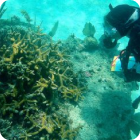
By: Kyle Grammatica
While COVID-19 keeps us at home, sea turtles are taking advantage of the empty shores. The beach shutdowns are giving our endangered sea turtle species more opportunities to nest, which could lead to a needed increase in population.
Sea Turtle Nesting and Human Presence
Researchers like Justin Perrault, Director of Research at the Loggerhead Marinelife Center, have noted that sea turtles are more likely to successfully nest when human presence on beaches is diminished. Sea turtle mothers spend a lot of time and energy getting on shore, laying their eggs, and then returning to the ocean. If human presence like lights and noise disturb them during this arduous process, they will often abandon the beach and go back to the water. Returning to the water without nesting is called a “false crawl,” resulting in fewer turtles.
With many beaches closed due to COVID-19, sea turtles are far less likely to be disturbed than usual, and false crawl rates will reduce this nesting season. As nesting season is just beginning for many sea turtle species, it’s still too early tell how significant the effect will be.
Turtle egg laying behavior
Data from agencies like the Florida Fish and Wildlife Conservation Commission (FWC) suggests that some species of sea turtles have cyclical nesting seasons with record breaking numbers of nests one year, followed by a low year, and then back to high numbers again. Researchers still do not fully understand this phenomenon. Last year, green sea turtle nest numbers were very high, while loggerheads and leatherbacks were on the lower end of historical standards. All of Florida’s sea turtle species are threatened or endangered, so the possibility of a high nesting season for all species is great news.
Loggerhead and green sea turtle eggs typically hatch in about 45-60 days, while leatherback eggs hatch in about 59-75 days. Loggerheads are the most frequent nesters on Florida’s beaches, followed by green and leatherback sea turtles. Florida also occasionally hosts Kemp’s Ridley and hawksbill sea turtle nests too. If you are able to contribute to their conservation in these uncertain times, please consider making a donation.













